CHC50113: Early Childhood Development and Wellbeing Project Report
VerifiedAdded on 2023/01/12
|12
|2483
|58
Report
AI Summary
This report delves into the holistic development and wellbeing of children in early childhood, encompassing physical, language, social, creative, and cognitive development stages. It explores these areas across different age groups, from 0-2 to 4-6 years, providing insights into developmental milestones and considerations. The report also discusses key theories, including Maturation theory and Social Learning Theory (Bandura), and their implications for early childhood educators. Furthermore, it highlights the importance of creating supportive environments and understanding children's responses to various stimuli. The conclusion emphasizes the significance of providing children with all abilities which have clear inclusion of special health care needs which is able to have the social, emotional and the education needs.
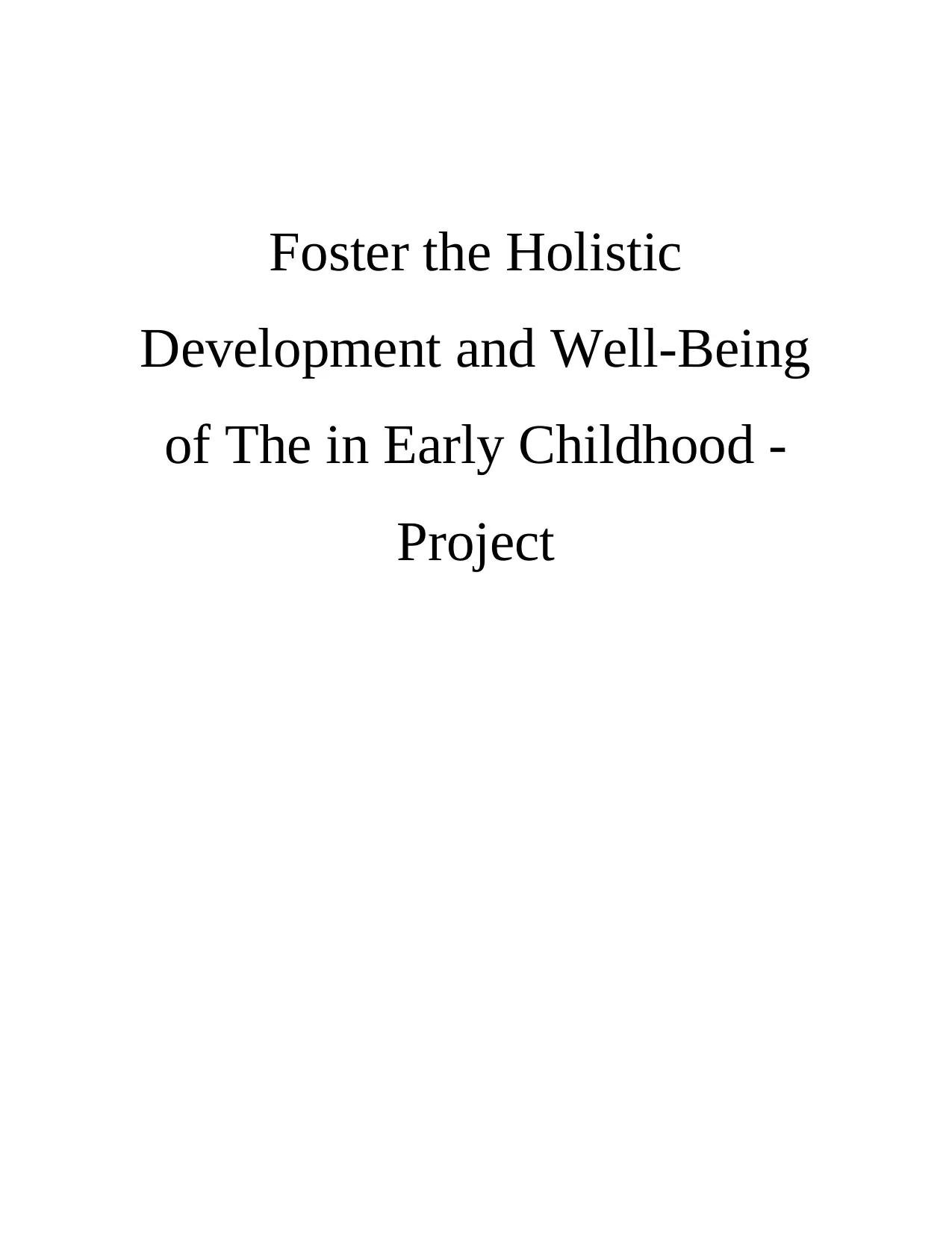
Foster the Holistic
Development and Well-Being
of The in Early Childhood -
Project
Development and Well-Being
of The in Early Childhood -
Project
Paraphrase This Document
Need a fresh take? Get an instant paraphrase of this document with our AI Paraphraser
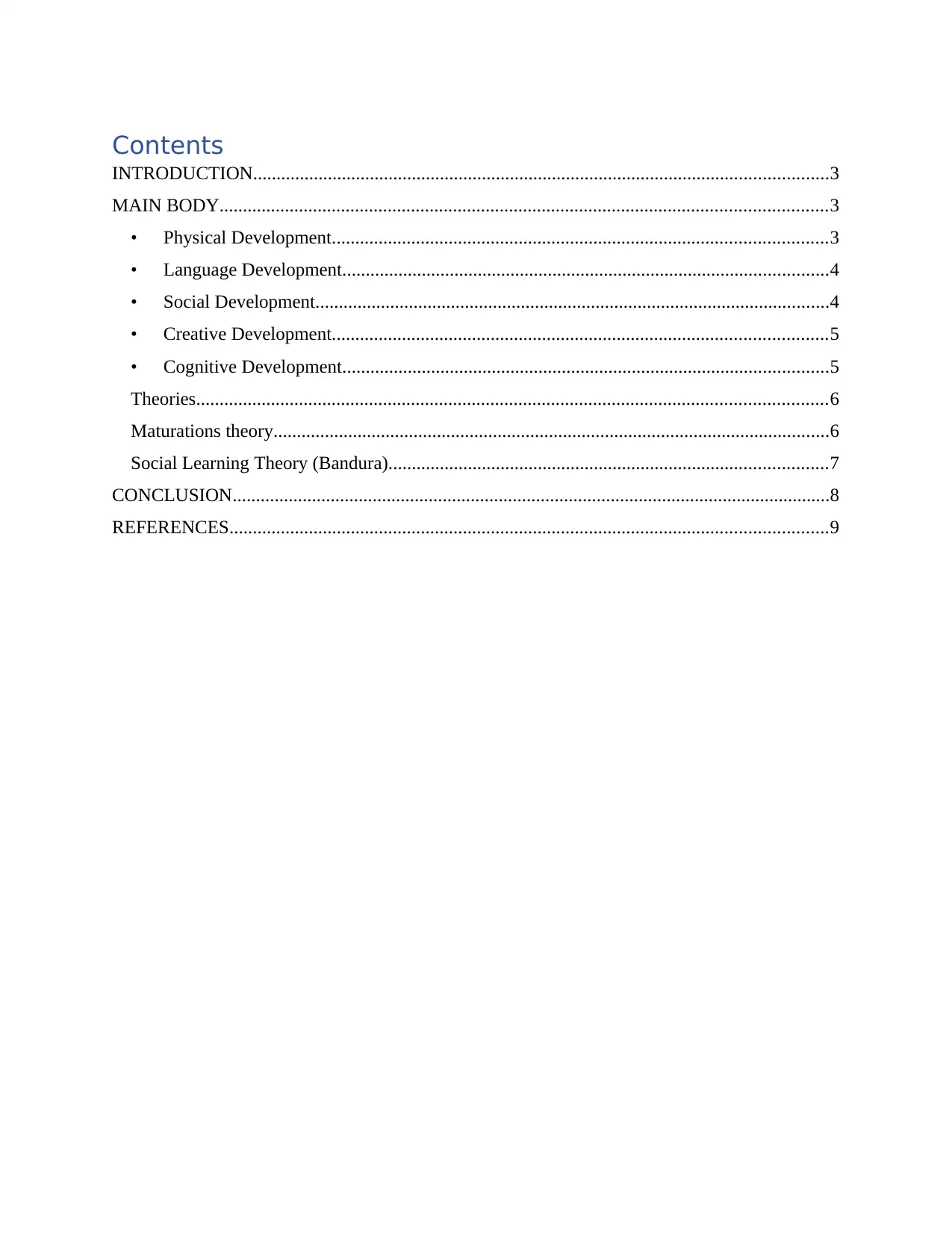
Contents
INTRODUCTION...........................................................................................................................3
MAIN BODY..................................................................................................................................3
• Physical Development..........................................................................................................3
• Language Development........................................................................................................4
• Social Development..............................................................................................................4
• Creative Development..........................................................................................................5
• Cognitive Development........................................................................................................5
Theories.......................................................................................................................................6
Maturations theory.......................................................................................................................6
Social Learning Theory (Bandura)..............................................................................................7
CONCLUSION................................................................................................................................8
REFERENCES................................................................................................................................9
INTRODUCTION...........................................................................................................................3
MAIN BODY..................................................................................................................................3
• Physical Development..........................................................................................................3
• Language Development........................................................................................................4
• Social Development..............................................................................................................4
• Creative Development..........................................................................................................5
• Cognitive Development........................................................................................................5
Theories.......................................................................................................................................6
Maturations theory.......................................................................................................................6
Social Learning Theory (Bandura)..............................................................................................7
CONCLUSION................................................................................................................................8
REFERENCES................................................................................................................................9
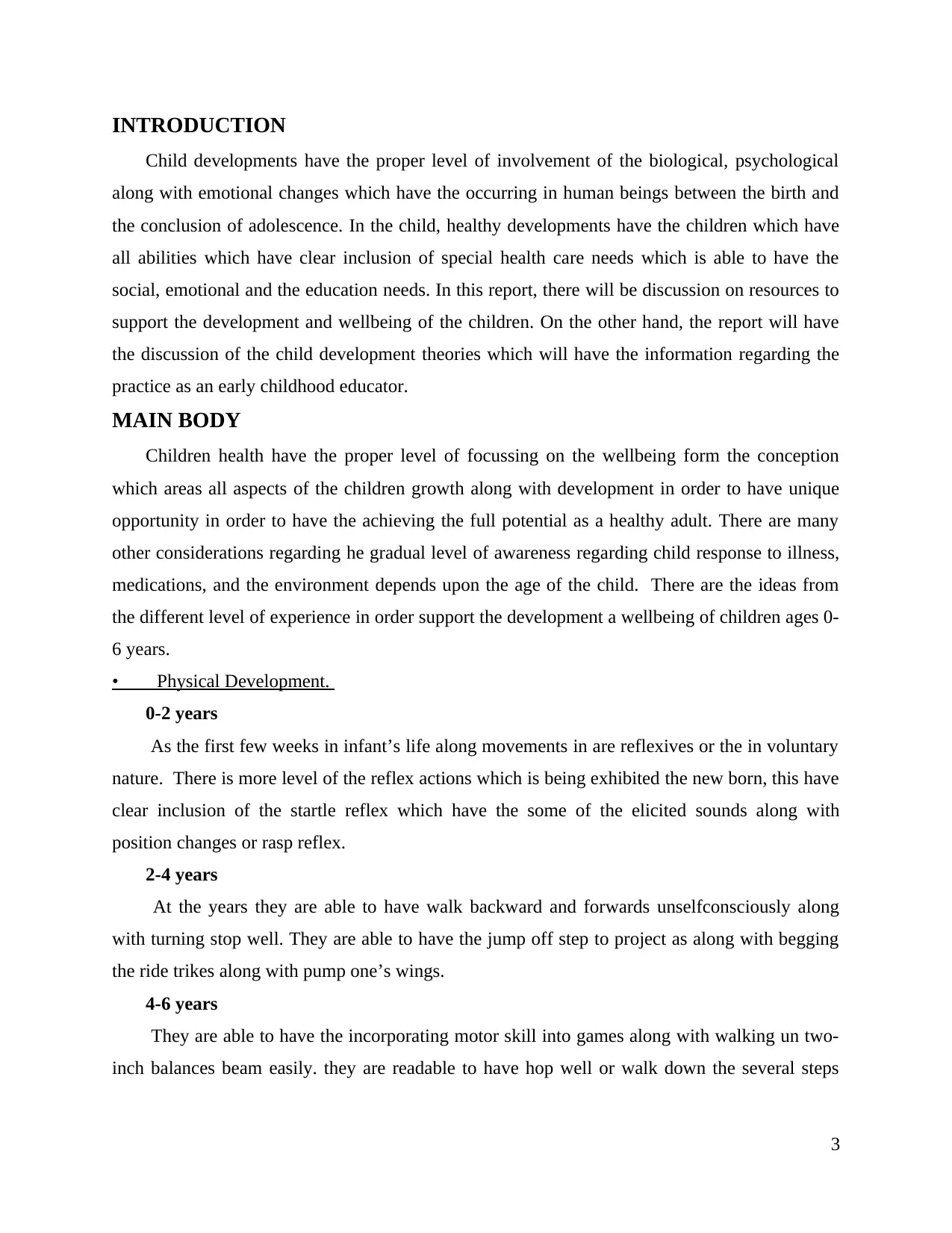
INTRODUCTION
Child developments have the proper level of involvement of the biological, psychological
along with emotional changes which have the occurring in human beings between the birth and
the conclusion of adolescence. In the child, healthy developments have the children which have
all abilities which have clear inclusion of special health care needs which is able to have the
social, emotional and the education needs. In this report, there will be discussion on resources to
support the development and wellbeing of the children. On the other hand, the report will have
the discussion of the child development theories which will have the information regarding the
practice as an early childhood educator.
MAIN BODY
Children health have the proper level of focussing on the wellbeing form the conception
which areas all aspects of the children growth along with development in order to have unique
opportunity in order to have the achieving the full potential as a healthy adult. There are many
other considerations regarding he gradual level of awareness regarding child response to illness,
medications, and the environment depends upon the age of the child. There are the ideas from
the different level of experience in order support the development a wellbeing of children ages 0-
6 years.
• Physical Development.
0-2 years
As the first few weeks in infant’s life along movements in are reflexives or the in voluntary
nature. There is more level of the reflex actions which is being exhibited the new born, this have
clear inclusion of the startle reflex which have the some of the elicited sounds along with
position changes or rasp reflex.
2-4 years
At the years they are able to have walk backward and forwards unselfconsciously along
with turning stop well. They are able to have the jump off step to project as along with begging
the ride trikes along with pump one’s wings.
4-6 years
They are able to have the incorporating motor skill into games along with walking un two-
inch balances beam easily. they are readable to have hop well or walk down the several steps
3
Child developments have the proper level of involvement of the biological, psychological
along with emotional changes which have the occurring in human beings between the birth and
the conclusion of adolescence. In the child, healthy developments have the children which have
all abilities which have clear inclusion of special health care needs which is able to have the
social, emotional and the education needs. In this report, there will be discussion on resources to
support the development and wellbeing of the children. On the other hand, the report will have
the discussion of the child development theories which will have the information regarding the
practice as an early childhood educator.
MAIN BODY
Children health have the proper level of focussing on the wellbeing form the conception
which areas all aspects of the children growth along with development in order to have unique
opportunity in order to have the achieving the full potential as a healthy adult. There are many
other considerations regarding he gradual level of awareness regarding child response to illness,
medications, and the environment depends upon the age of the child. There are the ideas from
the different level of experience in order support the development a wellbeing of children ages 0-
6 years.
• Physical Development.
0-2 years
As the first few weeks in infant’s life along movements in are reflexives or the in voluntary
nature. There is more level of the reflex actions which is being exhibited the new born, this have
clear inclusion of the startle reflex which have the some of the elicited sounds along with
position changes or rasp reflex.
2-4 years
At the years they are able to have walk backward and forwards unselfconsciously along
with turning stop well. They are able to have the jump off step to project as along with begging
the ride trikes along with pump one’s wings.
4-6 years
They are able to have the incorporating motor skill into games along with walking un two-
inch balances beam easily. they are readable to have hop well or walk down the several steps
3
⊘ This is a preview!⊘
Do you want full access?
Subscribe today to unlock all pages.

Trusted by 1+ million students worldwide
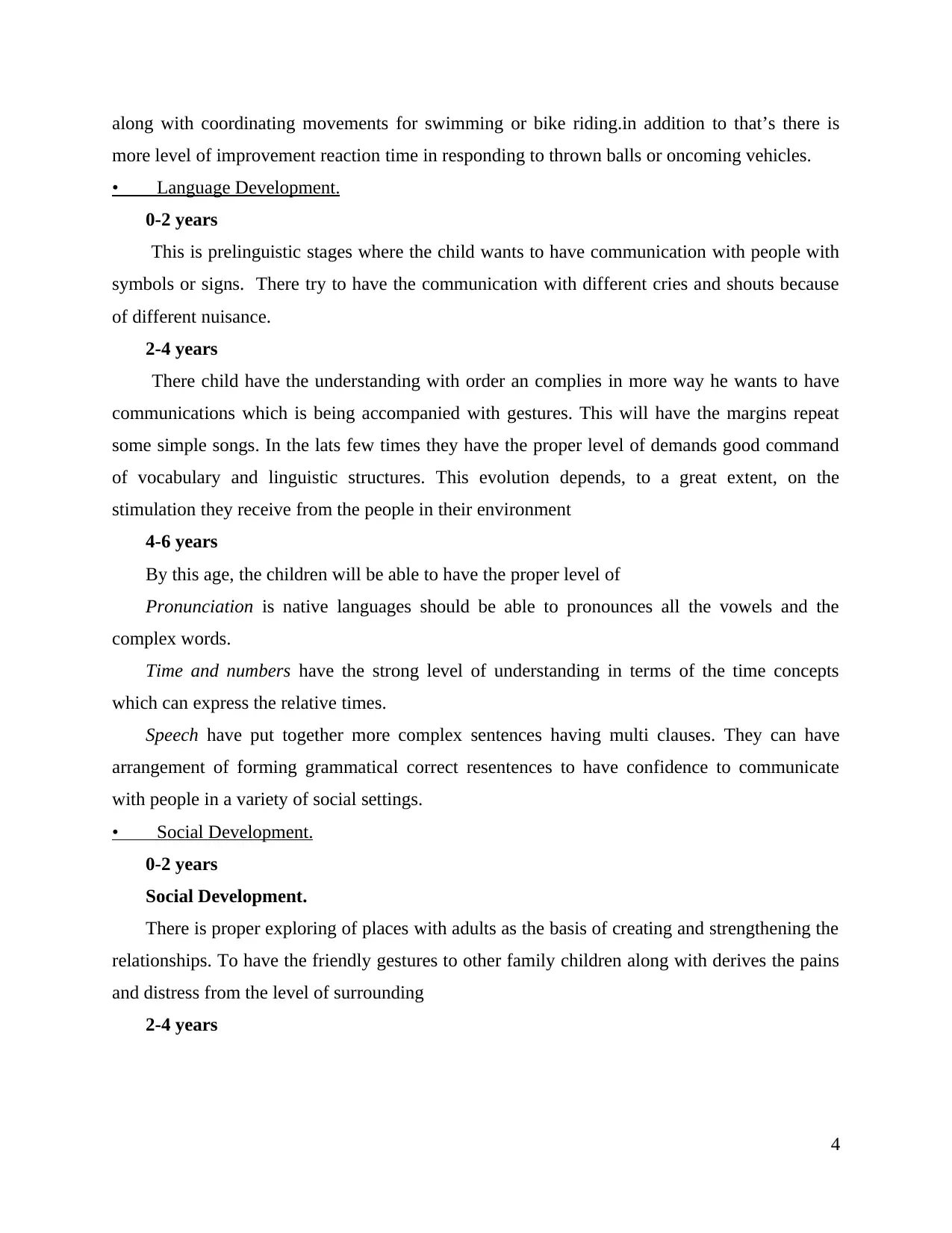
along with coordinating movements for swimming or bike riding.in addition to that’s there is
more level of improvement reaction time in responding to thrown balls or oncoming vehicles.
• Language Development.
0-2 years
This is prelinguistic stages where the child wants to have communication with people with
symbols or signs. There try to have the communication with different cries and shouts because
of different nuisance.
2-4 years
There child have the understanding with order an complies in more way he wants to have
communications which is being accompanied with gestures. This will have the margins repeat
some simple songs. In the lats few times they have the proper level of demands good command
of vocabulary and linguistic structures. This evolution depends, to a great extent, on the
stimulation they receive from the people in their environment
4-6 years
By this age, the children will be able to have the proper level of
Pronunciation is native languages should be able to pronounces all the vowels and the
complex words.
Time and numbers have the strong level of understanding in terms of the time concepts
which can express the relative times.
Speech have put together more complex sentences having multi clauses. They can have
arrangement of forming grammatical correct resentences to have confidence to communicate
with people in a variety of social settings.
• Social Development.
0-2 years
Social Development.
There is proper exploring of places with adults as the basis of creating and strengthening the
relationships. To have the friendly gestures to other family children along with derives the pains
and distress from the level of surrounding
2-4 years
4
more level of improvement reaction time in responding to thrown balls or oncoming vehicles.
• Language Development.
0-2 years
This is prelinguistic stages where the child wants to have communication with people with
symbols or signs. There try to have the communication with different cries and shouts because
of different nuisance.
2-4 years
There child have the understanding with order an complies in more way he wants to have
communications which is being accompanied with gestures. This will have the margins repeat
some simple songs. In the lats few times they have the proper level of demands good command
of vocabulary and linguistic structures. This evolution depends, to a great extent, on the
stimulation they receive from the people in their environment
4-6 years
By this age, the children will be able to have the proper level of
Pronunciation is native languages should be able to pronounces all the vowels and the
complex words.
Time and numbers have the strong level of understanding in terms of the time concepts
which can express the relative times.
Speech have put together more complex sentences having multi clauses. They can have
arrangement of forming grammatical correct resentences to have confidence to communicate
with people in a variety of social settings.
• Social Development.
0-2 years
Social Development.
There is proper exploring of places with adults as the basis of creating and strengthening the
relationships. To have the friendly gestures to other family children along with derives the pains
and distress from the level of surrounding
2-4 years
4
Paraphrase This Document
Need a fresh take? Get an instant paraphrase of this document with our AI Paraphraser
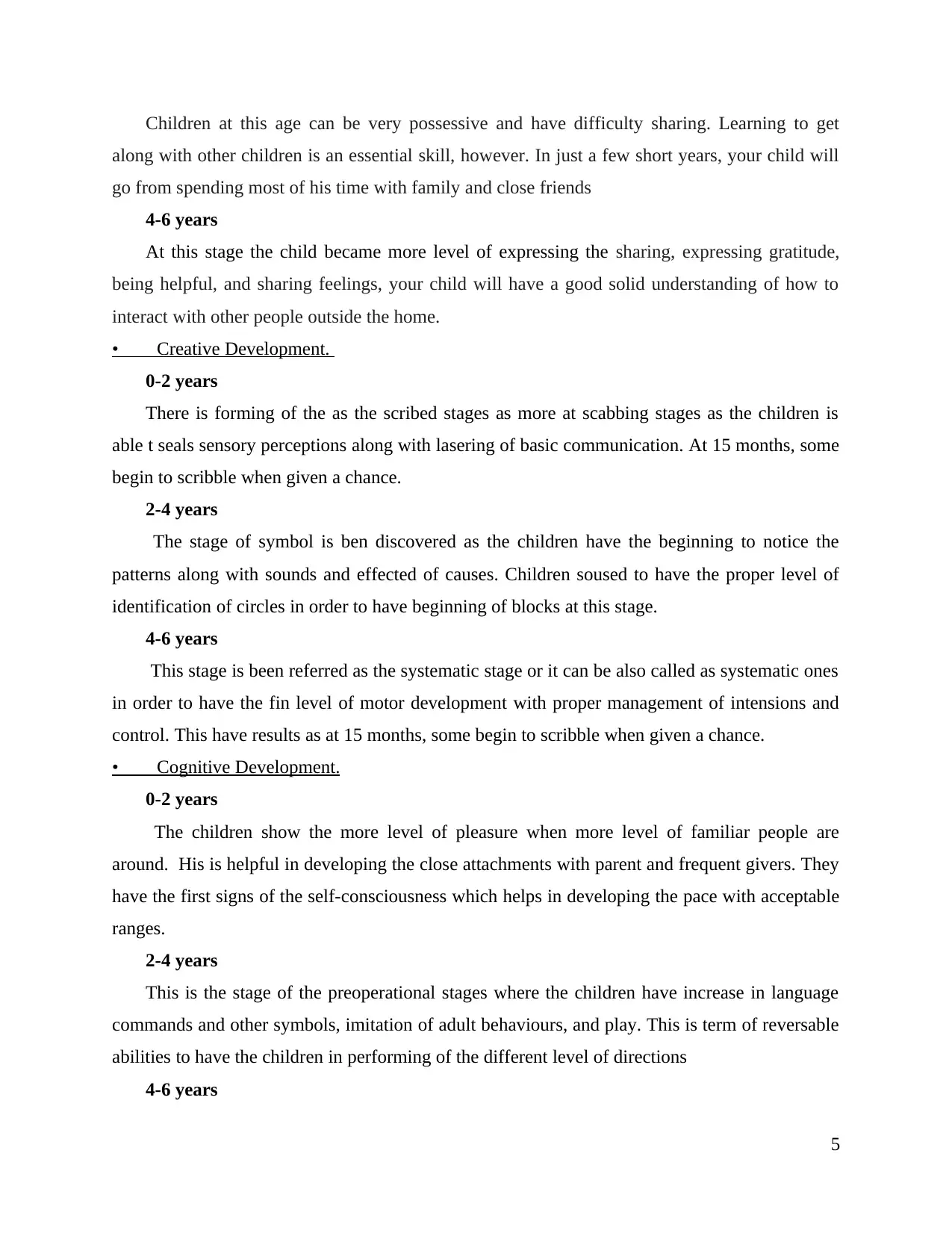
Children at this age can be very possessive and have difficulty sharing. Learning to get
along with other children is an essential skill, however. In just a few short years, your child will
go from spending most of his time with family and close friends
4-6 years
At this stage the child became more level of expressing the sharing, expressing gratitude,
being helpful, and sharing feelings, your child will have a good solid understanding of how to
interact with other people outside the home.
• Creative Development.
0-2 years
There is forming of the as the scribed stages as more at scabbing stages as the children is
able t seals sensory perceptions along with lasering of basic communication. At 15 months, some
begin to scribble when given a chance.
2-4 years
The stage of symbol is ben discovered as the children have the beginning to notice the
patterns along with sounds and effected of causes. Children soused to have the proper level of
identification of circles in order to have beginning of blocks at this stage.
4-6 years
This stage is been referred as the systematic stage or it can be also called as systematic ones
in order to have the fin level of motor development with proper management of intensions and
control. This have results as at 15 months, some begin to scribble when given a chance.
• Cognitive Development.
0-2 years
The children show the more level of pleasure when more level of familiar people are
around. His is helpful in developing the close attachments with parent and frequent givers. They
have the first signs of the self-consciousness which helps in developing the pace with acceptable
ranges.
2-4 years
This is the stage of the preoperational stages where the children have increase in language
commands and other symbols, imitation of adult behaviours, and play. This is term of reversable
abilities to have the children in performing of the different level of directions
4-6 years
5
along with other children is an essential skill, however. In just a few short years, your child will
go from spending most of his time with family and close friends
4-6 years
At this stage the child became more level of expressing the sharing, expressing gratitude,
being helpful, and sharing feelings, your child will have a good solid understanding of how to
interact with other people outside the home.
• Creative Development.
0-2 years
There is forming of the as the scribed stages as more at scabbing stages as the children is
able t seals sensory perceptions along with lasering of basic communication. At 15 months, some
begin to scribble when given a chance.
2-4 years
The stage of symbol is ben discovered as the children have the beginning to notice the
patterns along with sounds and effected of causes. Children soused to have the proper level of
identification of circles in order to have beginning of blocks at this stage.
4-6 years
This stage is been referred as the systematic stage or it can be also called as systematic ones
in order to have the fin level of motor development with proper management of intensions and
control. This have results as at 15 months, some begin to scribble when given a chance.
• Cognitive Development.
0-2 years
The children show the more level of pleasure when more level of familiar people are
around. His is helpful in developing the close attachments with parent and frequent givers. They
have the first signs of the self-consciousness which helps in developing the pace with acceptable
ranges.
2-4 years
This is the stage of the preoperational stages where the children have increase in language
commands and other symbols, imitation of adult behaviours, and play. This is term of reversable
abilities to have the children in performing of the different level of directions
4-6 years
5
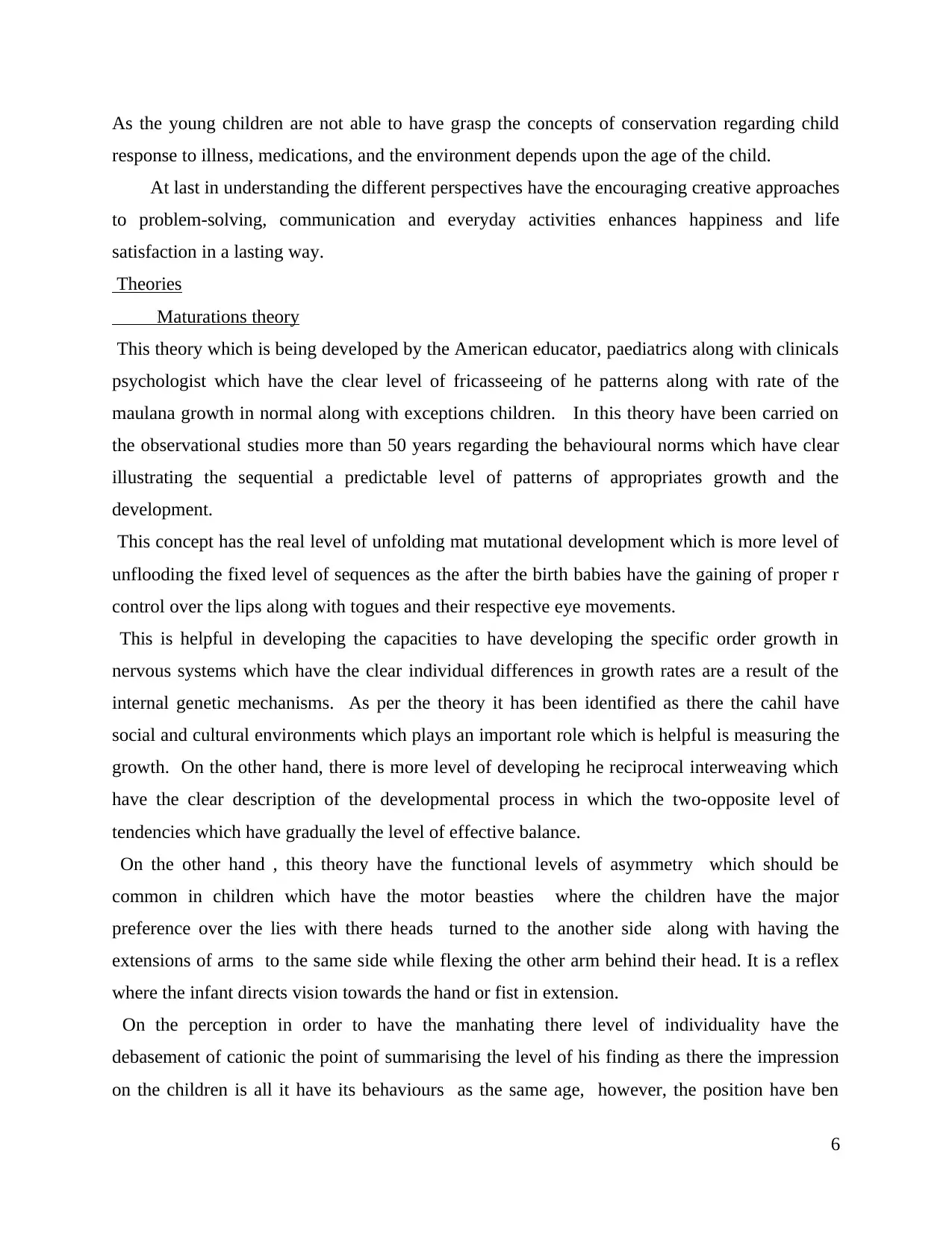
As the young children are not able to have grasp the concepts of conservation regarding child
response to illness, medications, and the environment depends upon the age of the child.
At last in understanding the different perspectives have the encouraging creative approaches
to problem-solving, communication and everyday activities enhances happiness and life
satisfaction in a lasting way.
Theories
Maturations theory
This theory which is being developed by the American educator, paediatrics along with clinicals
psychologist which have the clear level of fricasseeing of he patterns along with rate of the
maulana growth in normal along with exceptions children. In this theory have been carried on
the observational studies more than 50 years regarding the behavioural norms which have clear
illustrating the sequential a predictable level of patterns of appropriates growth and the
development.
This concept has the real level of unfolding mat mutational development which is more level of
unflooding the fixed level of sequences as the after the birth babies have the gaining of proper r
control over the lips along with togues and their respective eye movements.
This is helpful in developing the capacities to have developing the specific order growth in
nervous systems which have the clear individual differences in growth rates are a result of the
internal genetic mechanisms. As per the theory it has been identified as there the cahil have
social and cultural environments which plays an important role which is helpful is measuring the
growth. On the other hand, there is more level of developing he reciprocal interweaving which
have the clear description of the developmental process in which the two-opposite level of
tendencies which have gradually the level of effective balance.
On the other hand , this theory have the functional levels of asymmetry which should be
common in children which have the motor beasties where the children have the major
preference over the lies with there heads turned to the another side along with having the
extensions of arms to the same side while flexing the other arm behind their head. It is a reflex
where the infant directs vision towards the hand or fist in extension.
On the perception in order to have the manhating there level of individuality have the
debasement of cationic the point of summarising the level of his finding as there the impression
on the children is all it have its behaviours as the same age, however, the position have ben
6
response to illness, medications, and the environment depends upon the age of the child.
At last in understanding the different perspectives have the encouraging creative approaches
to problem-solving, communication and everyday activities enhances happiness and life
satisfaction in a lasting way.
Theories
Maturations theory
This theory which is being developed by the American educator, paediatrics along with clinicals
psychologist which have the clear level of fricasseeing of he patterns along with rate of the
maulana growth in normal along with exceptions children. In this theory have been carried on
the observational studies more than 50 years regarding the behavioural norms which have clear
illustrating the sequential a predictable level of patterns of appropriates growth and the
development.
This concept has the real level of unfolding mat mutational development which is more level of
unflooding the fixed level of sequences as the after the birth babies have the gaining of proper r
control over the lips along with togues and their respective eye movements.
This is helpful in developing the capacities to have developing the specific order growth in
nervous systems which have the clear individual differences in growth rates are a result of the
internal genetic mechanisms. As per the theory it has been identified as there the cahil have
social and cultural environments which plays an important role which is helpful is measuring the
growth. On the other hand, there is more level of developing he reciprocal interweaving which
have the clear description of the developmental process in which the two-opposite level of
tendencies which have gradually the level of effective balance.
On the other hand , this theory have the functional levels of asymmetry which should be
common in children which have the motor beasties where the children have the major
preference over the lies with there heads turned to the another side along with having the
extensions of arms to the same side while flexing the other arm behind their head. It is a reflex
where the infant directs vision towards the hand or fist in extension.
On the perception in order to have the manhating there level of individuality have the
debasement of cationic the point of summarising the level of his finding as there the impression
on the children is all it have its behaviours as the same age, however, the position have ben
6
⊘ This is a preview!⊘
Do you want full access?
Subscribe today to unlock all pages.

Trusted by 1+ million students worldwide
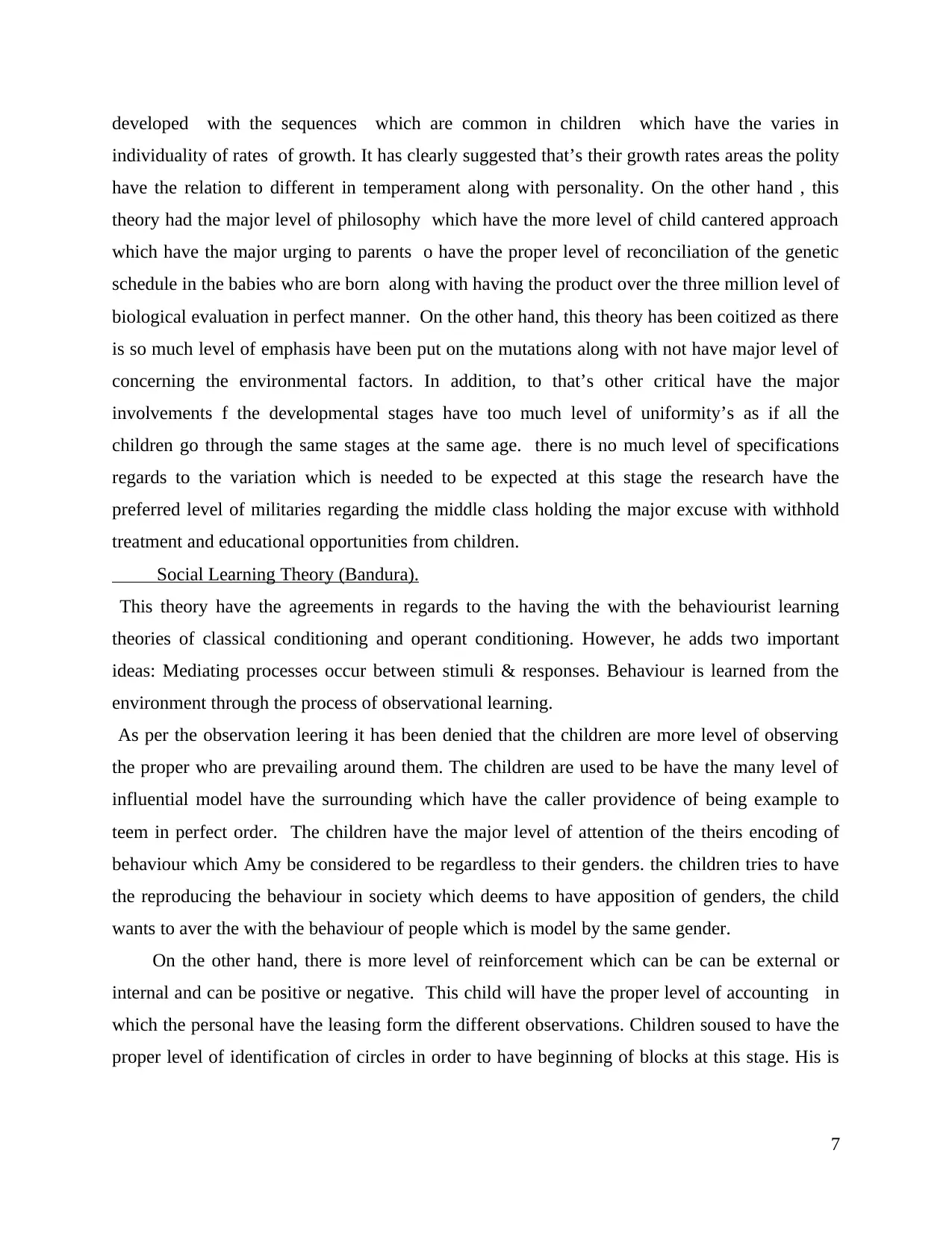
developed with the sequences which are common in children which have the varies in
individuality of rates of growth. It has clearly suggested that’s their growth rates areas the polity
have the relation to different in temperament along with personality. On the other hand , this
theory had the major level of philosophy which have the more level of child cantered approach
which have the major urging to parents o have the proper level of reconciliation of the genetic
schedule in the babies who are born along with having the product over the three million level of
biological evaluation in perfect manner. On the other hand, this theory has been coitized as there
is so much level of emphasis have been put on the mutations along with not have major level of
concerning the environmental factors. In addition, to that’s other critical have the major
involvements f the developmental stages have too much level of uniformity’s as if all the
children go through the same stages at the same age. there is no much level of specifications
regards to the variation which is needed to be expected at this stage the research have the
preferred level of militaries regarding the middle class holding the major excuse with withhold
treatment and educational opportunities from children.
Social Learning Theory (Bandura).
This theory have the agreements in regards to the having the with the behaviourist learning
theories of classical conditioning and operant conditioning. However, he adds two important
ideas: Mediating processes occur between stimuli & responses. Behaviour is learned from the
environment through the process of observational learning.
As per the observation leering it has been denied that the children are more level of observing
the proper who are prevailing around them. The children are used to be have the many level of
influential model have the surrounding which have the caller providence of being example to
teem in perfect order. The children have the major level of attention of the theirs encoding of
behaviour which Amy be considered to be regardless to their genders. the children tries to have
the reproducing the behaviour in society which deems to have apposition of genders, the child
wants to aver the with the behaviour of people which is model by the same gender.
On the other hand, there is more level of reinforcement which can be can be external or
internal and can be positive or negative. This child will have the proper level of accounting in
which the personal have the leasing form the different observations. Children soused to have the
proper level of identification of circles in order to have beginning of blocks at this stage. His is
7
individuality of rates of growth. It has clearly suggested that’s their growth rates areas the polity
have the relation to different in temperament along with personality. On the other hand , this
theory had the major level of philosophy which have the more level of child cantered approach
which have the major urging to parents o have the proper level of reconciliation of the genetic
schedule in the babies who are born along with having the product over the three million level of
biological evaluation in perfect manner. On the other hand, this theory has been coitized as there
is so much level of emphasis have been put on the mutations along with not have major level of
concerning the environmental factors. In addition, to that’s other critical have the major
involvements f the developmental stages have too much level of uniformity’s as if all the
children go through the same stages at the same age. there is no much level of specifications
regards to the variation which is needed to be expected at this stage the research have the
preferred level of militaries regarding the middle class holding the major excuse with withhold
treatment and educational opportunities from children.
Social Learning Theory (Bandura).
This theory have the agreements in regards to the having the with the behaviourist learning
theories of classical conditioning and operant conditioning. However, he adds two important
ideas: Mediating processes occur between stimuli & responses. Behaviour is learned from the
environment through the process of observational learning.
As per the observation leering it has been denied that the children are more level of observing
the proper who are prevailing around them. The children are used to be have the many level of
influential model have the surrounding which have the caller providence of being example to
teem in perfect order. The children have the major level of attention of the theirs encoding of
behaviour which Amy be considered to be regardless to their genders. the children tries to have
the reproducing the behaviour in society which deems to have apposition of genders, the child
wants to aver the with the behaviour of people which is model by the same gender.
On the other hand, there is more level of reinforcement which can be can be external or
internal and can be positive or negative. This child will have the proper level of accounting in
which the personal have the leasing form the different observations. Children soused to have the
proper level of identification of circles in order to have beginning of blocks at this stage. His is
7
Paraphrase This Document
Need a fresh take? Get an instant paraphrase of this document with our AI Paraphraser
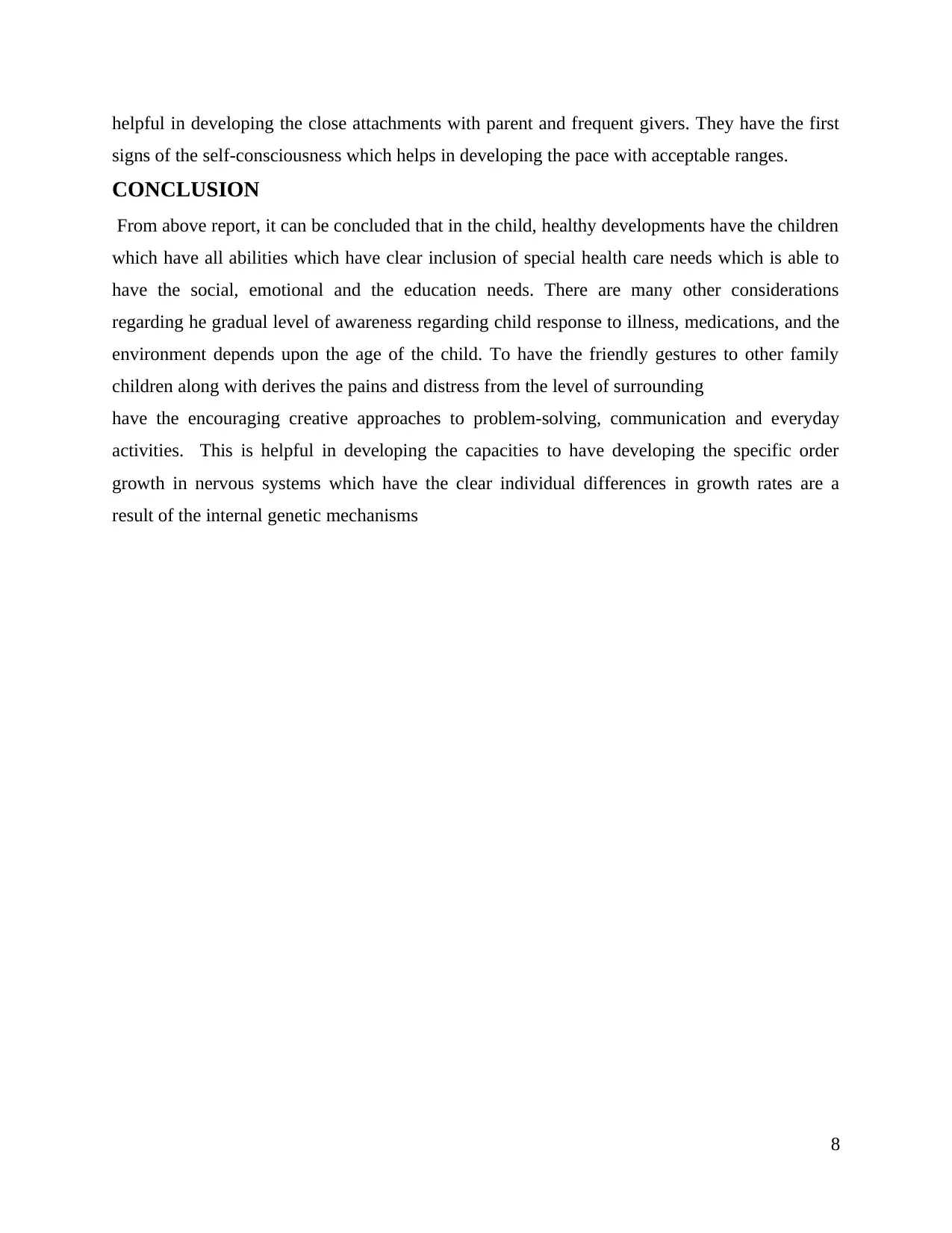
helpful in developing the close attachments with parent and frequent givers. They have the first
signs of the self-consciousness which helps in developing the pace with acceptable ranges.
CONCLUSION
From above report, it can be concluded that in the child, healthy developments have the children
which have all abilities which have clear inclusion of special health care needs which is able to
have the social, emotional and the education needs. There are many other considerations
regarding he gradual level of awareness regarding child response to illness, medications, and the
environment depends upon the age of the child. To have the friendly gestures to other family
children along with derives the pains and distress from the level of surrounding
have the encouraging creative approaches to problem-solving, communication and everyday
activities. This is helpful in developing the capacities to have developing the specific order
growth in nervous systems which have the clear individual differences in growth rates are a
result of the internal genetic mechanisms
8
signs of the self-consciousness which helps in developing the pace with acceptable ranges.
CONCLUSION
From above report, it can be concluded that in the child, healthy developments have the children
which have all abilities which have clear inclusion of special health care needs which is able to
have the social, emotional and the education needs. There are many other considerations
regarding he gradual level of awareness regarding child response to illness, medications, and the
environment depends upon the age of the child. To have the friendly gestures to other family
children along with derives the pains and distress from the level of surrounding
have the encouraging creative approaches to problem-solving, communication and everyday
activities. This is helpful in developing the capacities to have developing the specific order
growth in nervous systems which have the clear individual differences in growth rates are a
result of the internal genetic mechanisms
8
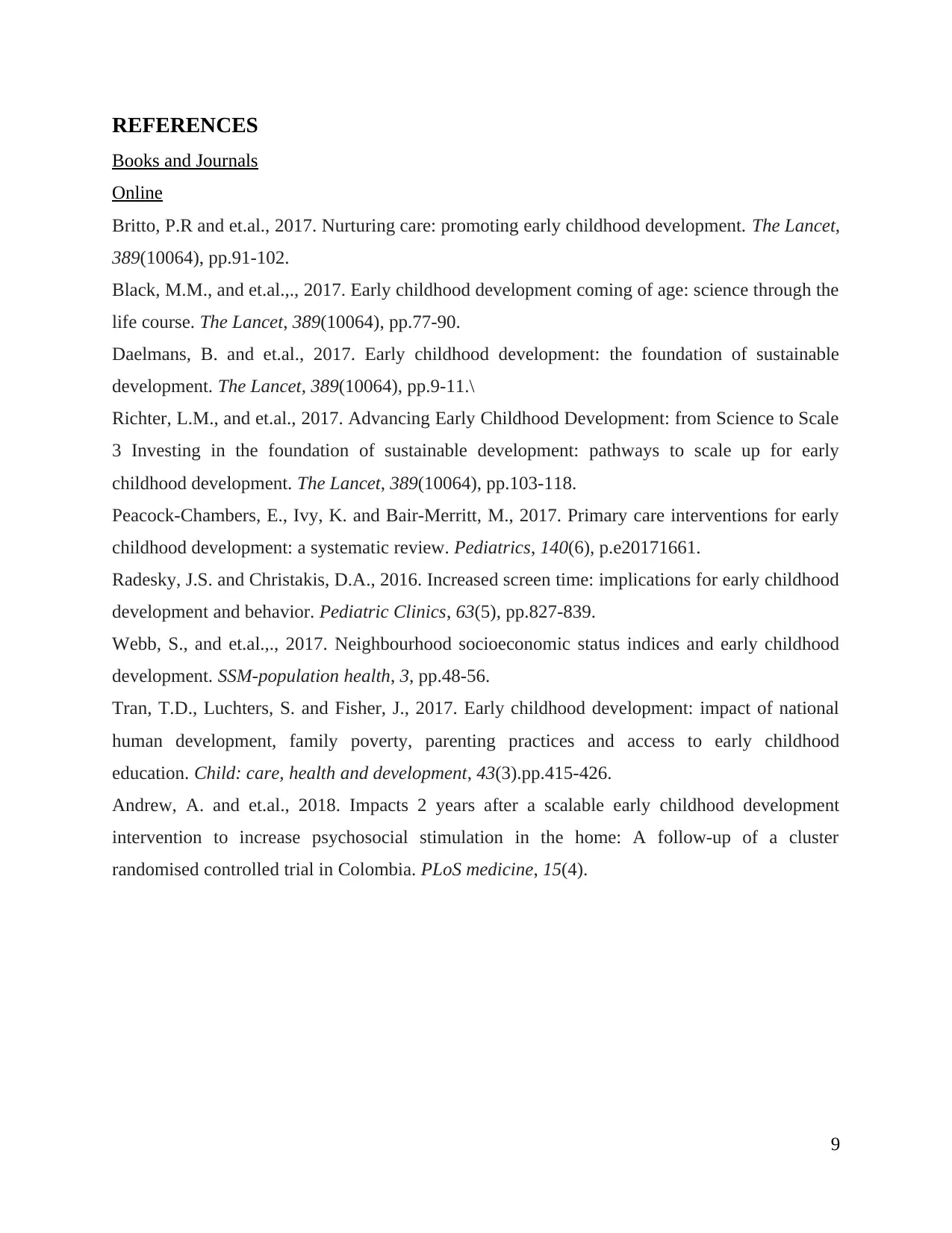
REFERENCES
Books and Journals
Online
Britto, P.R and et.al., 2017. Nurturing care: promoting early childhood development. The Lancet,
389(10064), pp.91-102.
Black, M.M., and et.al.,., 2017. Early childhood development coming of age: science through the
life course. The Lancet, 389(10064), pp.77-90.
Daelmans, B. and et.al., 2017. Early childhood development: the foundation of sustainable
development. The Lancet, 389(10064), pp.9-11.\
Richter, L.M., and et.al., 2017. Advancing Early Childhood Development: from Science to Scale
3 Investing in the foundation of sustainable development: pathways to scale up for early
childhood development. The Lancet, 389(10064), pp.103-118.
Peacock-Chambers, E., Ivy, K. and Bair-Merritt, M., 2017. Primary care interventions for early
childhood development: a systematic review. Pediatrics, 140(6), p.e20171661.
Radesky, J.S. and Christakis, D.A., 2016. Increased screen time: implications for early childhood
development and behavior. Pediatric Clinics, 63(5), pp.827-839.
Webb, S., and et.al.,., 2017. Neighbourhood socioeconomic status indices and early childhood
development. SSM-population health, 3, pp.48-56.
Tran, T.D., Luchters, S. and Fisher, J., 2017. Early childhood development: impact of national
human development, family poverty, parenting practices and access to early childhood
education. Child: care, health and development, 43(3).pp.415-426.
Andrew, A. and et.al., 2018. Impacts 2 years after a scalable early childhood development
intervention to increase psychosocial stimulation in the home: A follow-up of a cluster
randomised controlled trial in Colombia. PLoS medicine, 15(4).
9
Books and Journals
Online
Britto, P.R and et.al., 2017. Nurturing care: promoting early childhood development. The Lancet,
389(10064), pp.91-102.
Black, M.M., and et.al.,., 2017. Early childhood development coming of age: science through the
life course. The Lancet, 389(10064), pp.77-90.
Daelmans, B. and et.al., 2017. Early childhood development: the foundation of sustainable
development. The Lancet, 389(10064), pp.9-11.\
Richter, L.M., and et.al., 2017. Advancing Early Childhood Development: from Science to Scale
3 Investing in the foundation of sustainable development: pathways to scale up for early
childhood development. The Lancet, 389(10064), pp.103-118.
Peacock-Chambers, E., Ivy, K. and Bair-Merritt, M., 2017. Primary care interventions for early
childhood development: a systematic review. Pediatrics, 140(6), p.e20171661.
Radesky, J.S. and Christakis, D.A., 2016. Increased screen time: implications for early childhood
development and behavior. Pediatric Clinics, 63(5), pp.827-839.
Webb, S., and et.al.,., 2017. Neighbourhood socioeconomic status indices and early childhood
development. SSM-population health, 3, pp.48-56.
Tran, T.D., Luchters, S. and Fisher, J., 2017. Early childhood development: impact of national
human development, family poverty, parenting practices and access to early childhood
education. Child: care, health and development, 43(3).pp.415-426.
Andrew, A. and et.al., 2018. Impacts 2 years after a scalable early childhood development
intervention to increase psychosocial stimulation in the home: A follow-up of a cluster
randomised controlled trial in Colombia. PLoS medicine, 15(4).
9
⊘ This is a preview!⊘
Do you want full access?
Subscribe today to unlock all pages.

Trusted by 1+ million students worldwide

10
Paraphrase This Document
Need a fresh take? Get an instant paraphrase of this document with our AI Paraphraser

11

12
⊘ This is a preview!⊘
Do you want full access?
Subscribe today to unlock all pages.

Trusted by 1+ million students worldwide
1 out of 12
Related Documents
Your All-in-One AI-Powered Toolkit for Academic Success.
+13062052269
info@desklib.com
Available 24*7 on WhatsApp / Email
![[object Object]](/_next/static/media/star-bottom.7253800d.svg)
Unlock your academic potential
Copyright © 2020–2025 A2Z Services. All Rights Reserved. Developed and managed by ZUCOL.




